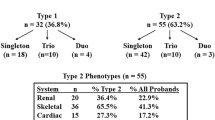Summary
The polymorphic locus D19S11 consists of four closely linked RFLPs: α, β, δ and γ on chromosome 19p13.2→19cen, revealed by subclones p13-1-82 and p13-2-21 from cosmid 1–13. Here, we report that p13-1-25, an additional subclone of c1-13, reveals three insertion/deletion RFLPs, α, ε, and ϕ, at the D19S11 locus. In situ hybridization of p13-1-25 to metaphase chromosomes from a carrier of a 19/X translocation with a breakpoint near the centromere confirms localization of D19S11 to 19p. Studies with hydatidiform moles have generated assignments of specific restriction fragments to these three loci, and genotypic studies in three-generation families have indicated that they are closely linked. Loci α (also detected by p13-1-82) and ϕ each have but two common alleles, whereas ε has at least 33 alleles, including a null allele. Fifty unrelated individuals tested displayed unique fragment patterns on Taq I blots probed with p13-1-25. Applications of this probe include monitoring loss of chromosome 19 during tumorigenesis, monitoring engraftment of donor bone marrow after transplantation, testing for paternity, and mapping disease genes on chromosome 19.
Similar content being viewed by others
References
Blazar BR, Orr HT, Arthur DC, Kersey JH, Filipovich AH (1985) Restriction fragment length polymorphisms (RFLPs) as markers of engraftment in allogeneic marrow transplantation. Blood 66: 1436–1444
Bufton L, Bruns GAP, Magenis RE, Tomar D, Shaw D, Brook D, Litt M (1986) Four restriction fragment length polymorphisms revealed by probes from a single cosmid map to chromosome 19. Am J Hum Genet 38:447–460
Ish-Horowicz D, Burke PJ (1981) Rapid and efficient cosmid cloning. Nucleic Acids Res 9:2989–2998
Jacobs PA, Wilson CM, Sprenkle JA, Rosenshein NB, Migeon BR (1980) Mechanism of orgin of complete hydatidiform moles. Nature 286:633–634
Jefferys AJ, Wilson V, Thein SL (1985) Hypervariable “minisatellite” regions in human DNA. Nature 314:67–73
Litt M, White R (1985) A highly polymorphic locus in human DNA revealed by cosmid-derived probes. Proc Natl Acad Sci USA 82: 6206–6210
Schweizer D (1980) Simultaneous fluorescent staining of R-bands and specific heterochromatic regions (DA-DAPI bands) in human chromosomes. Cytogenet Cell Genet 27:190–193
Surti U, Szulman AE (1987) Genetics of hydatifiform moles: Pittsburgh study. In: Ichinoe K (ed) Sapporo International Seminar on Trophoblastic Disease. Igaku-Shoin, Tokyo (in press)
White R, Leppert M, Bishop DT, Barker D, Berkowitz J, Brown C, Callahan P, Holm T, Jerominski L (1985) Construction of linkage maps with DNA markers for human chromosomes. Nature 313: 101–105
White R, Julier C, Leppert M, Nakamura Y, O'Connell P, Woodward S, Lathrop GM, Lalouel J-M (1987) Construction of human genetic linkage maps. I. Progress and perspectives. Cold Spring Harbor Symp Quant Biol 51 (in press)
Wong Z, Wilson V, Jefferys AJ, Thein SL (1986) Cloning a selected fragment from a human DNA “fingerprint”: isolation of an extremely polymorphic minisatellite. Nucleic Acids Res 14:4605–4616
Author information
Authors and Affiliations
Rights and permissions
About this article
Cite this article
Buroker, N.E., Bufton, L., Surti, U. et al. A hypervariable region at the D19S11 locus. Hum Genet 76, 90–95 (1987). https://doi.org/10.1007/BF00283056
Received:
Revised:
Issue Date:
DOI: https://doi.org/10.1007/BF00283056




